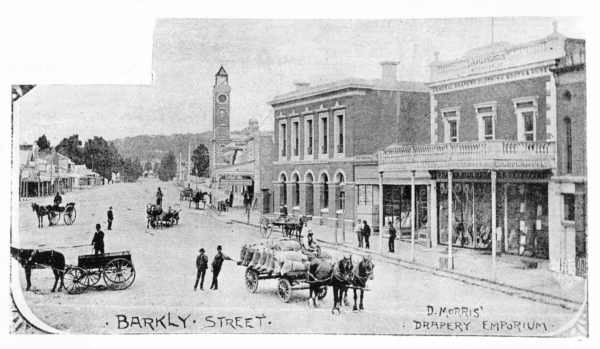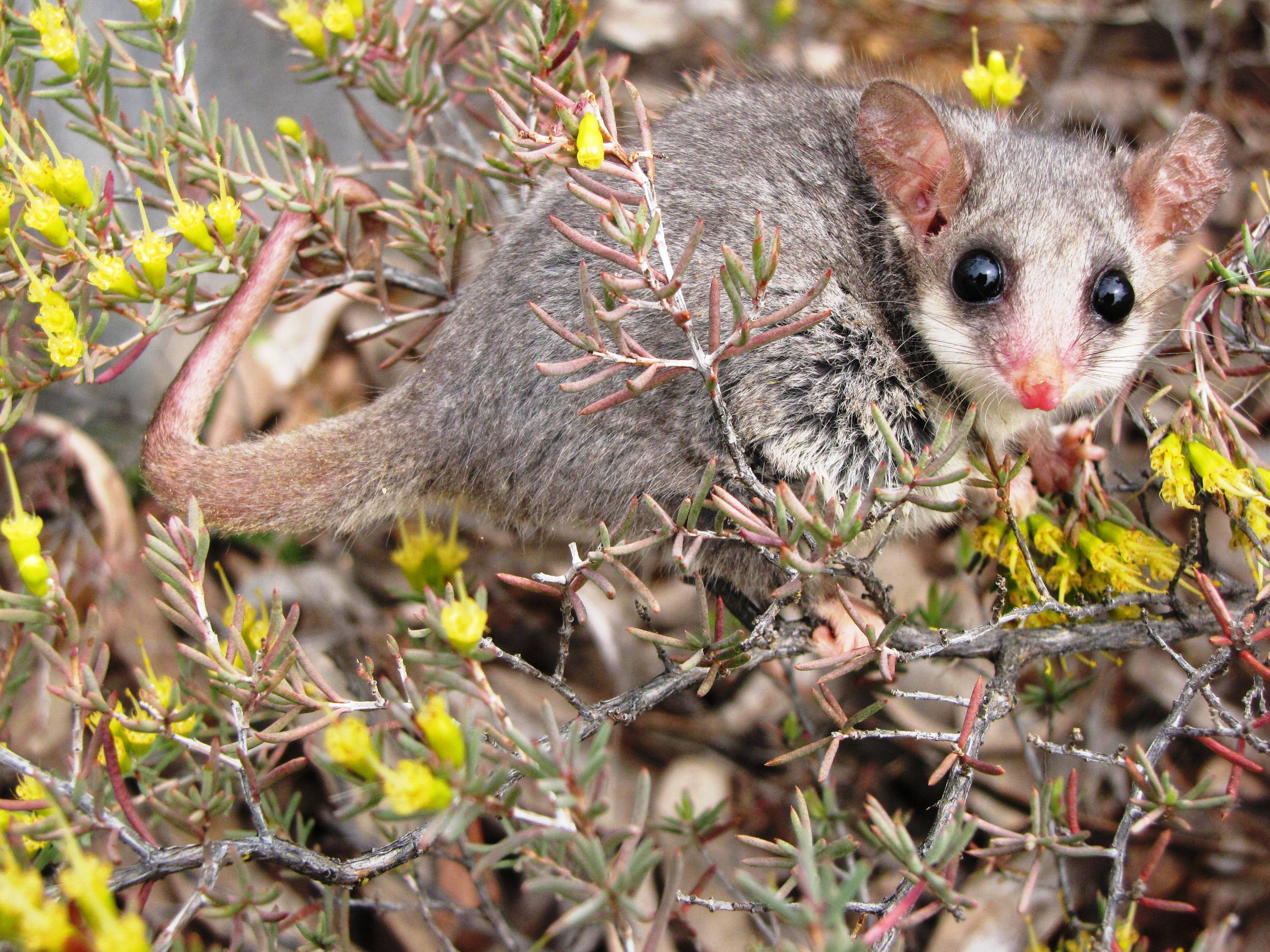|
Mount Buangor State Park
Mount Buangor State Park is located 60 kilometres west of Ballarat, Victoria in Bayindeen. The 2400-hectare park takes in varied eucalypt forest, creek flats, a waterfall, steep escarpments, and the area's highest peak, Mount Buangor (987 m.). The park contains a 15 km network of walking trails. The eucalypt trees include Yarra gums, manna gums, blue gums, messmates, narrow-leaved peppermint gums, snow gums and red stringybarks, as well as large tree ferns. More than 130 species of birds have been recorded in the Mount Cole State Forest, which includes the park. Fauna includes echidnas, eastern grey kangaroos, wallabies, possums, gliders and bats, as well as introduced deer. The local Aboriginal people were the Beeripmo Balug clan of the Djab Wurrung The Djab Wurrung, also spelt Djabwurrung, Tjapwurrung, Tjap Wurrung, or Djapwarrung, people are Aboriginal Australians whose country is the volcanic plains of central Victoria from the Mount William Range of Ga ... [...More Info...] [...Related Items...] OR: [Wikipedia] [Google] [Baidu] |
Ararat, Victoria
Ararat (Djabwurrung: ''Tallarambooroo'') is a city in south-west Victoria, Australia, about west of Melbourne, on the Western Highway on the eastern slopes of the Ararat Hills and Cemetery Creek valley between Victoria's Western District and the Wimmera. Its urban population according to 2021 census is 8,500 and services the region of 11,880 residents across the Rural City's boundaries. It is also the home of the 2018/19 GMGA Golf Championship Final. It is the largest settlement in the Rural City of Ararat local government area and is the administrative centre. The discovery of gold in 1857 during the Victorian gold rush transformed it into a boomtown which continued to prosper until the turn of the 20th century, after which it has steadily declined in population. It was proclaimed as a city on 24 May 1950. After a decline in population over the 1980s and 90s, there has been a small but steady increase in the population, and it is the site of many existing and future, la ... [...More Info...] [...Related Items...] OR: [Wikipedia] [Google] [Baidu] |
Echidna
Echidnas (), sometimes known as spiny anteaters, are quill-covered monotremes (egg-laying mammals) belonging to the family Tachyglossidae . The four extant species of echidnas and the platypus are the only living mammals that lay eggs and the only surviving members of the order Monotremata. The diet of some species consists of ants and termites, but they are not closely related to the true anteaters of the Americas, which (along with sloths and armadillos) are xenarthrans. Echidnas live in Australia and New Guinea. Echidnas evolved between 20 and 50 million years ago, descending from a platypus-like monotreme. This ancestor was aquatic, but echidnas adapted to life on land. Etymology Echidnas are named after Echidna, a creature from Greek mythology who was half-woman, half-snake, as the animal was perceived to have qualities of both mammals and reptiles. An alternative explanation is a confusion with . Physical characteristics Echidnas are medium-sized, solitar ... [...More Info...] [...Related Items...] OR: [Wikipedia] [Google] [Baidu] |
Thomas Mitchell (explorer)
Sir Thomas Livingstone Mitchell (15 June 1792 – 5 October 1855), surveyor and explorer of Southeastern Australia, was born at Grangemouth in Stirlingshire, Scotland. In 1827 he took up an appointment as Assistant Surveyor General of New South Wales. The following year he became Surveyor General and remained in this position until his death. Mitchell was knighted in 1839 for his contribution to the surveying of Australia. Early life Born in Scotland on 15 June 1792, he was son of John Mitchell of Carron Works and was brought up from childhood by his uncle, Thomas Livingstone of Parkhall, Stirlingshire. Peninsular War On the death of his uncle, he joined the British army in Portugal as a volunteer in the Peninsular War, at the age of sixteen. On 24 June 1811, at the age of nineteen, he received his first commission as 2nd Lieutenant in the 1st Battalion 95th Rifles (later the Rifle Brigade / Royal Green Jackets). Utilising his skills as a draughtsman of outstanding ab ... [...More Info...] [...Related Items...] OR: [Wikipedia] [Google] [Baidu] |
Djab Wurrung
The Djab Wurrung, also spelt Djabwurrung, Tjapwurrung, Tjap Wurrung, or Djapwarrung, people are Aboriginal Australians whose country is the volcanic plains of central Victoria from the Mount William Range of Gariwerd in the west to the Pyrenees range in the east encompassing the Wimmera River flowing north and the headwaters of the Hopkins River flowing south. The towns of Ararat, Stawell and Hamilton are within their territory. The Djab Wurrung Heritage Protection Embassy is located on a proposed highway duplication on the Western Highway south of Ararat. There were 41 Djab Wurrung clans who formed an alliance with the neighbouring Jardwadjali people through intermarriage, shared culture, trade and moiety system before colonisation. Their lands were conquered but never ceded. Language Djab Wurrung, meaning "soft language", belongs to the Western branch of the Kulin languages. It is the southernmost language, with Dja Dja Wurrung spoken to the east/southeast, and Jardw ... [...More Info...] [...Related Items...] OR: [Wikipedia] [Google] [Baidu] |
Deer
Deer or true deer are hoofed ruminant mammals forming the family Cervidae. The two main groups of deer are the Cervinae, including the muntjac, the elk (wapiti), the red deer, and the fallow deer; and the Capreolinae, including the reindeer (caribou), white-tailed deer, the roe deer, and the moose. Male deer of all species (except the water deer), as well as female reindeer, grow and shed new antlers each year. In this they differ from permanently horned antelope, which are part of a different family ( Bovidae) within the same order of even-toed ungulates (Artiodactyla). The musk deer ( Moschidae) of Asia and chevrotains ( Tragulidae) of tropical African and Asian forests are separate families that are also in the ruminant clade Ruminantia; they are not especially closely related to Cervidae. Deer appear in art from Paleolithic cave paintings onwards, and they have played a role in mythology, religion, and literature throughout history, as well as in hera ... [...More Info...] [...Related Items...] OR: [Wikipedia] [Google] [Baidu] |
Petauridae
Petauridae is a family of possums containing 13 species: four species of trioks and striped possum (genus ''Dactylopsila''), eight species of wrist-winged glider (genus ''Petaurus''), and Leadbeater's possum (''Gymnobelideus leadbeateri''), which has only vestigial gliding membranes. Most of the wrist-winged gliders are native to Australia, whereas most of the striped possums to New Guinea, but some members of each group are found on both sides of the Torres Strait. Leadbeater's possum is endemic to Victoria, Australia. Evolution All petaurids have obvious facial markings, a well-defined dorsal stripe, very large lower front incisors, and four-cusped molars. Despite their distinctive appearance, petaurids are closely related to the ringtail possums (family Pseudocheiridae) and are grouped together with them to form the superfamily Petauroidea. The wrist-winged gliders are omnivorous, specialising on sap and nectar, but taking a wide variety of supplemental foods. The gliders ... [...More Info...] [...Related Items...] OR: [Wikipedia] [Google] [Baidu] |
Phalangeriformes
Phalangeriformes is a paraphyletic suborder of about 70 species of small to medium-sized arboreal marsupials native to Australia, New Guinea, and Sulawesi. The species are commonly known as possums, gliders, and cuscus. The common name "possum" for various Phalangeriformes species derives from the creatures' resemblance to the opossums of the Americas (the term comes from Powhatan language ''aposoum'' "white animal", from Proto-Algonquian *''wa·p-aʔɬemwa'' "white dog"). However, although opossums are also marsupials, Australasian possums are more closely related to other Australasian marsupials such as kangaroos. Phalangeriformes are quadrupedal diprotodont marsupials with long tails. The smallest species, indeed the smallest diprotodont marsupial, is the Tasmanian pygmy possum, with an adult head-body length of and a weight of . The largest are the two species of bear cuscus, which may exceed . Phalangeriformes species are typically nocturnal and at least partia ... [...More Info...] [...Related Items...] OR: [Wikipedia] [Google] [Baidu] |
Wallaby
A wallaby () is a small or middle-sized macropod native to Australia and New Guinea, with introduced populations in New Zealand, Hawaii, the United Kingdom and other countries. They belong to the same taxonomic family as kangaroos and sometimes the same genus, but kangaroos are specifically categorised into the four largest species of the family. The term "wallaby" is an informal designation generally used for any macropod that is smaller than a kangaroo or a wallaroo that has not been designated otherwise. There are nine species (eight extant and one extinct) of the brush wallaby (genus ''Notamacropus''). Their head and body length is and the tail is long. The 19 known species of rock-wallabies (genus ''Petrogale'') live among rocks, usually near water; two species in this genus are endangered. The two living species of hare-wallabies (genus ''Lagorchestes''; two other species in this genus are extinct) are small animals that have the movements and some of the habits ... [...More Info...] [...Related Items...] OR: [Wikipedia] [Google] [Baidu] |
Mount Cole State Forest
The Mount Cole State Forest is in western Victoria, Australia, near the town of Beaufort. The forest is around Mount Cole, which formed 390 million years ago. The Indigenous Australians, the Beeripmo balug people, called it ''Bereep-bereep'', which means ''wild''. The forest covers an area of 12,150 hectares, including the forest around Mount Lonarch. The forest is on a plateau which is above grassy plains. The plateau is about 760 metres above sea level. High peaks in the forest include Mount Buangor (1,090 metres), Mount Cole (899 metres) and Ben Nevis (877 metres). The main trees in the southern part of the forest are Messmate (Eucalyptus obliqua), Manna Gum (Eucalyptus viminalis), and Blue Gums (Eucalyptus globulus). In the north, which is drier, there are Yellow Box (Eucalyptus melliodora), and Red Stringybark (Eucalyptus macrorhyncha). There is also the rare Mount Cole Grevillea, Grevillea montis-cole. On the high peaks there are groups of Snow Gums (Eucalyptus pauciflo ... [...More Info...] [...Related Items...] OR: [Wikipedia] [Google] [Baidu] |
Ballarat
Ballarat ( ) is a city in the Central Highlands of Victoria, Australia. At the 2021 Census, Ballarat had a population of 116,201, making it the third largest city in Victoria. Estimated resident population, 30 June 2018. Within months of Victoria separating from the colony of New South Wales in 1851, gold was discovered near Ballarat, sparking the Victorian gold rush. Ballarat subsequently became a thriving boomtown that for a time rivalled Melbourne, the capital of Victoria, in terms of wealth and cultural influence. In 1854, following a period of civil disobedience in Ballarat over gold licenses, local miners launched an armed uprising against government forces. Known as the Eureka Rebellion, it led to the introduction of male suffrage in Australia, and as such is interpreted as the origin of Australian democracy. The rebellion's symbol, the Eureka Flag, has become a national symbol. It was on display at Ballarat's Museum of Australian Democracy at Eureka (MADE) fro ... [...More Info...] [...Related Items...] OR: [Wikipedia] [Google] [Baidu] |
Eucalyptus Macrorhyncha
''Eucalyptus macrorhyncha'', commonly known as the red stringybark, is a species of medium-sized tree that is endemic to eastern Australia. It has rough, stringy, grey to brown bark, lance-shaped adult leaves, flower buds in groups of between seven and eleven, white flowers and hemispherical fruit. Description ''Eucalyptus macrorhyncha'' is a tree that typically grows to a height of and forms a lignotuber. It has rough, stringy, grey to reddish brown bark on the trunk and branches. Young plants and coppice regrowth have egg-shaped leaves long and wide. Adult leaves are lance-shaped to curved, the same dull to glossy green colour on both sides, long and wide on a petiole long. The flower buds are arranged in groups of seven, nine or eleven in leaf axils on an unbranched peduncle long, the individual buds on pedicels long. Mature buds are diamond-shaped, long and wide with a beaked operculum. Flowering occurs between February and July and the flowers are white. The fru ... [...More Info...] [...Related Items...] OR: [Wikipedia] [Google] [Baidu] |



.jpg)



